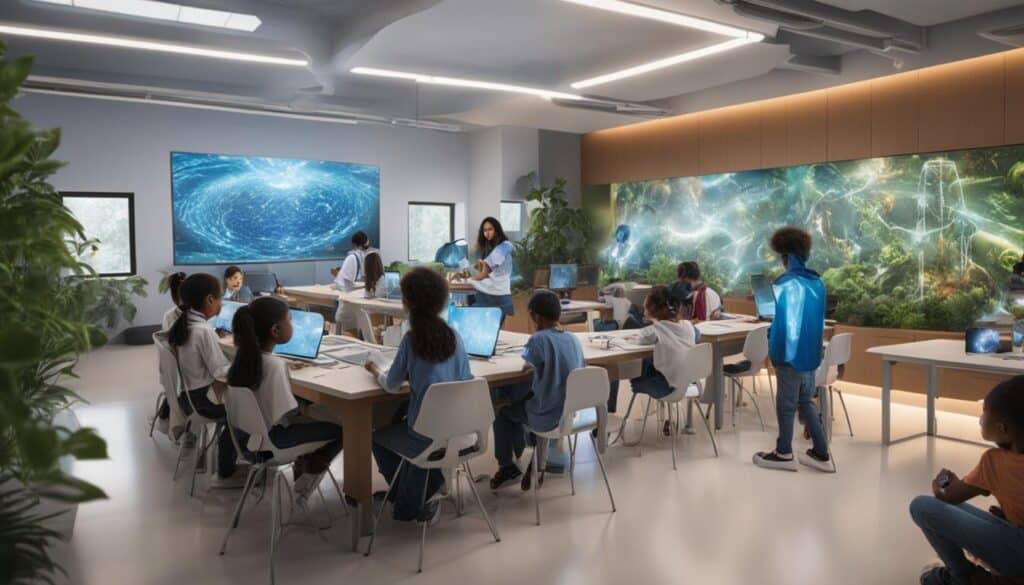Medical education presents a multitude of opportunities for individuals interested in pursuing a career in healthcare. It not only equips students and professionals with advanced clinical skills but also nurtures leadership qualities necessary for driving healthcare innovation. In a rapidly evolving medical landscape, medical education serves as a vital platform for unlocking the full potential of individuals and preparing them for successful careers in the healthcare industry.
Key Takeaways : Medical Education
- Medical education provides training in advanced clinical skills and promotes leadership in healthcare innovation.
- It prepares individuals for successful careers in the ever-changing healthcare industry.
- Medical education plays a crucial role in unlocking the potential of students and professionals in healthcare.
- It equips individuals with the skills and knowledge needed to adapt to the evolving medical landscape.
- Medical education offers numerous opportunities for career growth and development in healthcare.
Challenges in Undergraduate Medical Education
Undergraduate medical education faces a multitude of challenges that impact the quality of medical training and the preparedness of future healthcare professionals. These challenges can be classified into internal and external factors that require careful attention and strategic planning.
Internal Challenges
One internal challenge in undergraduate medical education is the traditionally disease-focused approach, which may overshadow the importance of understanding patient behavior and social determinants of health. This narrow focus can hinder the development of well-rounded physicians who can address the complex needs of diverse patient populations.
In addition, there is an ongoing debate between the merits of inpatient versus outpatient education. While inpatient settings provide valuable exposure to acute care scenarios, outpatient settings offer opportunities for long-term patient management and coordination of care across healthcare settings. Striking a balance between these two settings is crucial for comprehensive medical training.
Another internal challenge lies in the implications of faculty research predominantly focused on the molecular level. While cutting-edge research is essential for medical advancements, it is equally important to ensure that faculty are equipped with the skills and knowledge to teach clinical principles effectively to their students.
External Factors
External factors also pose challenges to undergraduate medical education. One of the prominent challenges is the exponential growth of medical knowledge. The ever-expanding body of medical knowledge necessitates continuous curriculum updates and adaptations to ensure that students are equipped with the most up-to-date information.
Technological innovations have revolutionized healthcare delivery, presenting a need to integrate digital literacy and technological competencies into the curriculum. Students must be prepared to utilize advancements such as telemedicine, electronic health records, and artificial intelligence in their future practice.
Societal changes, including shifting demographics, new healthcare reform policies, and evolving patient expectations, also impact medical education. Future healthcare professionals must be equipped with cultural competency, advocacy skills, and the ability to adapt to an ever-changing healthcare landscape.
Addressing the Challenges
To overcome these challenges, undergraduate medical education requires decisive institutional leadership and proactive curriculum development. Education institutions need to explore innovative teaching methods, incorporate interprofessional education, and strike a balance between foundational knowledge and practical skills.
By creating a dynamic and adaptable curriculum, medical schools can equip students with the necessary skills and knowledge to meet future healthcare demands. Faculty development programs can also support educators in staying updated with advancements in medical education and integrating them into their teaching practices.
“The future of medical education hinges on our ability to adapt to internal challenges and respond effectively to external factors. By thoughtfully addressing these challenges, we can produce competent and compassionate healthcare professionals who can thrive in a rapidly evolving healthcare landscape.”
Furthermore, fostering collaboration between medical schools, healthcare organizations, and policymakers can ensure that undergraduate medical education meets the needs of both patients and society as a whole.
By acknowledging and actively addressing the challenges in undergraduate medical education, institutions can cultivate resilient and adaptable healthcare professionals who can navigate the complexities of modern healthcare systems.
| Challenges | Description |
|---|---|
| Internal Challenges |
|
| External Factors |
|
The Future of Medical Education
As the healthcare system continues to evolve, medical schools are embracing the need for curricular redesign to meet the changing demands of the industry. Recognizing the importance of preparing future healthcare professionals who can adapt to the evolving landscape, various organizations have made recommendations for medical education reform.
At the core of this reform is the focus on the educational mission. Medical schools are reevaluating their goals and objectives to align with the needs of the healthcare system and society at large. The educational mission now extends beyond imparting medical knowledge to encompass cultivating critical thinking skills, fostering empathy, and promoting a patient-centered approach.
The development of new curricular models is also a key aspect of medical education reform. Traditional teaching methods are being complemented or replaced by innovative approaches that integrate foundational knowledge, clinical skills, and real-world experiences. These models emphasize interdisciplinary collaboration, evidence-based practice, and the use of technology in healthcare delivery.
One such curricular model is the problem-based learning (PBL) approach. PBL encourages students to actively engage in solving complex medical cases, promoting critical thinking, teamwork, and clinical reasoning skills. This model also provides opportunities for students to develop effective communication skills and learn about ethical considerations in patient care.
Medical schools are reinventing their educational programs to produce future healthcare professionals who are not only competent in medical knowledge and skills but also adaptable, compassionate, and equipped to navigate the complexities of modern healthcare.
Another curricular model gaining traction is competency-based education (CBE). CBE focuses on the mastery of specific competencies rather than the completion of a set curriculum within a fixed time frame. This approach allows learners to progress at their own pace, mastering competencies before advancing to the next level. CBE also promotes lifelong learning and recognizes the diverse learning styles and backgrounds of students.
By embracing medical education reform and adopting new curricular models, medical schools are shaping the future of healthcare education. These changes aim to produce future healthcare professionals who are well-rounded, adaptable, and equipped to meet the evolving needs of patients and society.
The Benefits of Medical Education Reform
Medical education reform holds numerous benefits for both students and the healthcare system. By aligning education with the needs of the healthcare system, future healthcare professionals will be better prepared to address the challenges and opportunities of the evolving landscape.
Some key benefits of medical education reform include:
- Enhanced clinical competency: The focus on competency-based education ensures that students have the necessary skills and knowledge to provide high-quality care to patients.
- Interdisciplinary collaboration: Curricular models that emphasize interdisciplinary collaboration prepare future healthcare professionals to work effectively as part of a healthcare team.
- Patient-centered care: By incorporating patient-centered care into the curriculum, medical schools are training students to prioritize the needs and preferences of patients.
- Innovation and adaptability: The integration of technology and real-world experiences in the curriculum equips students with the skills and mindset to embrace innovation and adapt to advancements in healthcare.
Through medical education reform, the healthcare system can ensure that future healthcare professionals are equipped to provide high-quality, patient-centered care in a rapidly changing healthcare landscape.

The Expansion of Medical Knowledge
Medical knowledge is constantly evolving and expanding at an exponential rate. With new discoveries, advancements, and research being conducted every day, it is crucial for medical education to keep pace with this rapid growth. The doubling time of medical knowledge, which represents the time it takes for the amount of medical knowledge to double, has significantly decreased over the years, reflecting the overwhelming influx of new information.
Exponential growth in medical knowledge means that the rate of expansion is accelerating. As a result, medical professionals need to adapt and develop effective coping strategies to stay up-to-date with the latest advancements and breakthroughs. Simply adding more material or extending the duration of the curriculum is no longer sufficient to keep pace with this exponential growth.
In order to address this challenge, a fundamental change in medical education is necessary. Medical schools and institutions must reassess their approach and prioritize strategies that incorporate ongoing learning and adaptability. This may involve restructuring curricula to focus on core competencies, critical thinking, and problem-solving skills. By embracing a lifelong learning mindset, future healthcare professionals can better navigate the ever-expanding body of medical knowledge.
To illustrate the magnitude of this expansion, consider the knowledge doubling time in medicine. In the early 1900s, medical knowledge doubled approximately every 150 years. By the 1950s, it had decreased to around 50 years. Today, it is estimated that medical knowledge doubles every 73 days, and this rate is predicted to continue decreasing.
“The expansion of medical knowledge requires a fundamental change in medical education to meet the demands of our rapidly evolving healthcare landscape.” – Dr. Rebecca Johnson, Medical Education Expert
Medical schools and educational institutions are recognizing the need for innovative approaches that promote continuous learning. They are exploring new methods, such as incorporating technology in medical education, implementing case-based learning, and fostering interprofessional collaboration. These strategies aim to equip future healthcare professionals with the necessary skills and mindset to adapt and thrive in an environment of exponential knowledge growth.
Incorporating Coping Strategies
In addition to fundamental changes, it is essential for medical education to emphasize the development of coping strategies. Healthcare professionals must be equipped with the tools and skills to manage the overwhelming influx of new information effectively.
One coping strategy is the cultivation of critical appraisal skills. This involves the ability to assess the quality and relevance of research and medical literature. By honing these skills, healthcare professionals can navigate the vast amount of information available and differentiate between credible and less reliable sources.
Another important coping strategy is collaboration and teamwork among healthcare professionals. In a rapidly evolving field, no individual can stay abreast of all developments. By working in interdisciplinary teams and sharing knowledge, healthcare professionals can collectively stay informed and provide the best possible care for their patients.

| Year | Knowledge Doubling Time |
|---|---|
| Early 1900s | Approximately 150 years |
| 1950s | Around 50 years |
| Present Day | Every 73 days |
Innovations in Medical Education
The Association of American Medical Colleges (AAMC) is at the forefront of driving innovations in medical education. They offer a wide range of resources and opportunities to enhance the learning experience and professional development of medical students and healthcare professionals.
Learning Events and Professional Development
AAMC organizes learning events and conferences that provide an interactive platform for medical professionals to exchange knowledge, discuss emerging trends, and explore cutting-edge research. These learning events offer valuable insights and practical skills that can be applied in the field of medicine. Additionally, they facilitate collaboration and networking among peers, fostering a culture of continuous learning and growth.
AAMC’s learning events and professional development conferences provide a unique opportunity for medical professionals to stay updated with the latest advancements in their respective fields and cultivate a mindset of lifelong learning.
Curriculum Resources and Leadership Development
AAMC is committed to providing comprehensive curriculum resources that support the development of well-rounded medical professionals. These resources include evidence-based educational materials, teaching guides, and innovative instructional methodologies. By leveraging these resources, institutions can create dynamic and engaging curricula tailored to meet the evolving needs of the healthcare industry.
In addition to curricular support, AAMC offers leadership development programs that empower medical professionals to become effective leaders in healthcare organizations. These programs focus on cultivating key leadership competencies, strategic thinking, and collaborative decision-making. By nurturing leadership skills, AAMC empowers healthcare professionals to drive positive change and address the challenges and opportunities in the ever-changing landscape of medical practice.
Regional Meetings and Collaboration
AAMC facilitates regional meetings where medical professionals from different geographic areas can come together to share best practices, exchange ideas, and collaborate on research projects. These meetings create a platform for peer-to-peer learning and collaboration, fostering a sense of community within the medical education ecosystem. Through regional meetings, healthcare professionals can gain unique perspectives, expand their networks, and form valuable professional relationships.
The Association of American Medical Colleges (AAMC) is dedicated to advancing medical education and supporting the growth and development of future healthcare professionals. Through their diverse range of initiatives, including learning events, professional development conferences, curriculum resources, leadership development programs, and regional meetings, AAMC plays a vital role in shaping the future of medical education.
| Initiative | Description |
|---|---|
| Learning Events | Interactive conferences and workshops to exchange knowledge and explore emerging trends. |
| Professional Development | Opportunities for healthcare professionals to enhance their skills and stay updated with advancements in their fields. |
| Curriculum Resources | Evidence-based materials and teaching guides to support the development of comprehensive curricula. |
| Leadership Development | Programs that empower medical professionals to become effective leaders in healthcare organizations. |
| Regional Meetings | Conferences that foster collaboration and networking among medical professionals from different regions. |
The Three Phases of Medical Education
Medical education encompasses three distinct phases: undergraduate medical education, graduate medical education (GME), and continuing medical education. Each phase plays a vital role in shaping the career progression and ongoing professional development of healthcare professionals.
Undergraduate Medical Education
Undergraduate medical education serves as the foundation for aspiring physicians. It refers to the initial phase of medical education, typically completed in medical schools or universities. During this phase, students undergo a rigorous admissions process to gain entry into medical school. The admissions process is highly selective, ensuring that only the most qualified individuals are accepted. The curriculum in undergraduate medical education focuses on providing students with a comprehensive understanding of the biomedical sciences and clinical skills.
Graduate Medical Education (GME)
Graduate medical education (GME) follows the completion of undergraduate medical education and refers to the residency training programs taken by physicians-in-training, commonly known as residents. GME provides specialization in various medical disciplines and allows residents to gain hands-on experience in clinical settings. It is during this phase that physicians develop the necessary knowledge and skills to practice medicine independently. Residency training programs are typically overseen by medical schools or teaching hospitals, ensuring a structured and supervised learning environment.
Continuing Medical Education
Continuing medical education (CME) is an ongoing process that ensures physicians’ professional development throughout their careers. It involves activities and programs designed to enhance knowledge, skills, and performance in clinical practice. CME covers a broad range of topics, including advancements in medical research, emerging technologies, and evolving healthcare practices. Physicians engage in CME to stay current with medical advancements, maintain competency, and provide high-quality patient care.

| Phase | Description |
|---|---|
| Undergraduate Medical Education | The initial phase of medical education focusing on the biomedical sciences and clinical skills. |
| Graduate Medical Education (GME) | Specialized residency training programs that provide hands-on experience in clinical settings. |
| Continuing Medical Education | Ongoing professional development activities to enhance knowledge, skills, and performance. |
Changes in Medical Education Structure and Content
Medical education is continually adapting to reflect the evolving landscape of healthcare. To ensure that future healthcare professionals are well-prepared, medical schools are implementing changes in both structure and content. These changes aim to provide a comprehensive and relevant educational experience.
Content Revision
One significant aspect of these changes is the revision of content. Medical schools are recognizing the importance of addressing topics such as chronic illness management and nonmedical issues to equip students with the necessary skills and knowledge for comprehensive patient care. By incorporating these subjects into the curriculum, students will develop a broader understanding of healthcare beyond the traditional biomedical model.
Case-Based Learning
Case-based learning is another innovation being embraced by medical schools. This active learning method allows students to apply their knowledge to real-world scenarios, further enhancing their critical thinking and problem-solving skills. By engaging in case-based learning, students develop a deeper understanding of medical concepts and gain practical experience in diagnosis and treatment.
Interprofessional Education
Recognizing the importance of collaboration in healthcare, medical schools are increasingly incorporating interprofessional education into their curricula. This approach fosters collaboration and teamwork among future healthcare professionals, preparing them to work effectively in multidisciplinary healthcare teams. By learning alongside students from other healthcare disciplines, medical students gain insight into the roles and skills of other professionals, facilitating better patient-centered care.
“Integrating nonmedical topics and interprofessional education into the curriculum equips future healthcare professionals with the skills to address the complex healthcare needs of diverse patient populations.” – Dr. Emily Davis, Medical Education Expert
In addition to these changes, medical schools are integrating the basic and clinical sciences to provide a more comprehensive learning experience. By connecting foundational knowledge with its practical application, students gain a deeper understanding of the medical concepts they learn.
To understand the impact of these changes, let’s take a look at the following table:
| Changes in Medical Education Structure and Content | Benefits |
|---|---|
| Content revision | Enhanced understanding of chronic illness management and nonmedical issues |
| Case-based learning | Improved critical thinking and problem-solving skills |
| Interprofessional education | Enhanced collaboration and teamwork skills |
| Integration of basic and clinical sciences | Deeper understanding of medical concepts |
These changes in medical education structure and content signify the commitment of medical schools to prepare future healthcare professionals who are equipped to address the complex healthcare challenges of today and tomorrow.

Innovations in GME and Residency Training
As medical education constantly evolves, so does graduate medical education (GME) and residency training. In response to the changing healthcare landscape, innovative approaches are being developed to optimize the duration of GME and tailor training to meet the specific needs of the community.
One area of focus is curriculum design. GME programs are being redesigned to address community health needs, ensuring that future healthcare professionals are equipped with the necessary skills and knowledge. By incorporating a holistic review of student performance, GME programs can better assess competency and identify areas for improvement.
Another significant development is the shift towards competency-based advancement. Discussions are underway to move away from time-based advancement and instead focus on measuring the achievement of specific competencies. This approach allows residents to advance at their own pace based on demonstrated proficiency, ensuring that they are adequately prepared to provide high-quality care.
Innovations in GME and residency training aim to foster a comprehensive learning experience that prepares healthcare professionals to meet the demands of the healthcare system. By integrating community health needs, curriculum design, holistic review, and competency-based advancement, GME programs are at the forefront of shaping the future of medical education.
Medical education is a comprehensive journey that begins in medical school and continues through training, professional development, and graduate medical education. Medical students embark on a path of learning, gaining essential knowledge and skills in health science, patient safety, and quality improvement. Through experiential learning environments, trainees have the opportunity to work alongside clinicians in teaching hospitals, fostering a qualitative and interprofessional learning experience.
Postgraduate education research contributes to the ongoing improvement of the learning environment, while online learning platforms offer flexibility for continuing professional development. As health professionals, clinicians engage in lifelong learning, participating in continuing medical education (CME) programs to stay abreast of advancements in healthcare and enhance patient care.
Also Read : Exploring High-Demand Medical Careers in the US
FAQs
Q: What are the opportunities for medical students in postgraduate education?
A: Medical students have the opportunity to further their education and training through postgraduate programs that focus on specialized areas of medicine.
Q: How can medical professionals benefit from online learning in medical education?
A: Medical professionals can access online learning platforms to enhance their knowledge and skills in various medical subjects, allowing for flexible and convenient learning.
Q: What is the significance of diversity and inclusion in medical education?
A: Diversity and inclusion in medical education are crucial for creating a more representative and culturally sensitive healthcare workforce that can effectively address the needs of a diverse patient population.
Q: What is the role of examination in medical education?
A: Examinations in medical education serve as assessments to evaluate the knowledge and skills of medical students, ensuring they meet the required standards to practice medicine.
Q: How can health professionals engage in continuing professional development (CPD) in the field of medicine?
A: Health professionals can participate in CPD activities such as workshops, conferences, and online courses to stay updated with the latest advancements in medical practice and enhance their professional skills.
Q: What are the goals of medical education?
A: The goals of medical education include preparing future clinicians to provide high-quality patient care, fostering research skills in health science, and promoting lifelong learning and professional development.
Q: What is the importance of research in medical education?
A: Research in medical education helps improve teaching methods, assess the effectiveness of educational interventions, and advance the overall quality of medical training to meet the evolving needs of healthcare systems.
Source Links
- https://www.ncbi.nlm.nih.gov/pmc/articles/PMC3116346/
- https://www.aamc.org/about-us/mission-areas/medical-education
- https://www.aamc.org/media/19151/download





